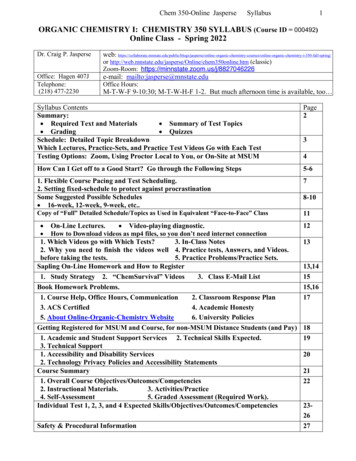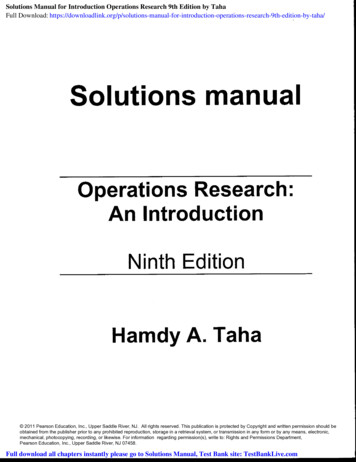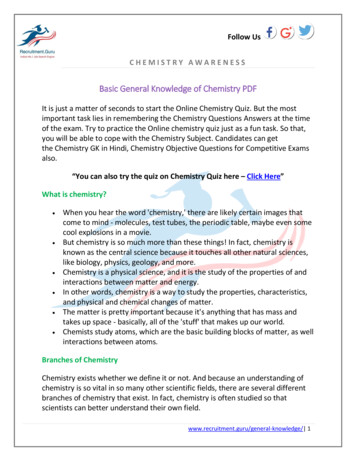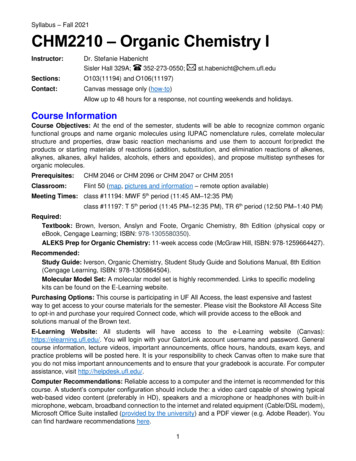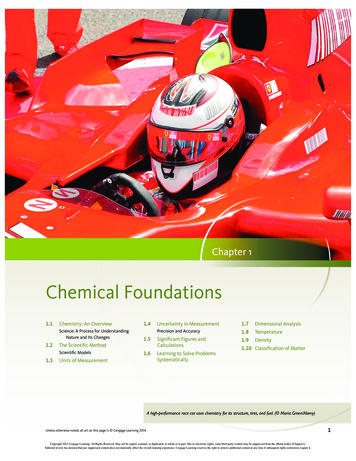
Transcription
Chapter 1Chemical Foundations1.1Chemistry: An OverviewScience: A Process for UnderstandingNature and Its Changes1.2Uncertainty in Measurement1.7Dimensional AnalysisPrecision and Accuracy1.8Temperature1.5Significant Figures andCalculations1.9Density1.6Learning to Solve ProblemsSystematicallyThe Scientific MethodScientific Models1.31.4Units of Measurement1.10 Classification of MatterA high-performance race car uses chemistry for its structure, tires, and fuel. ( Maria Green/Alamy)Unless otherwise noted, all art on this page is Cengage Learning 2014.Copyright 2012 Cengage Learning. All Rights Reserved. May not be copied, scanned, or duplicated, in whole or in part. Due to electronic rights, some third party content may be suppressed from the eBook and/or eChapter(s).Editorial review has deemed that any suppressed content does not materially affect the overall learning experience. Cengage Learning reserves the right to remove additional content at any time if subsequent rights restrictions require it.1
When you start your car, do you think about chemistry? Probably not, but youshould. The power to start your car is furnished by a lead storage battery.How does this battery work, and what does it contain? When a battery goes dead, whatdoes that mean? If you use a friend’s car to “jump-start” your car, did you know thatyour battery could explode? How can you avoid such an unpleasant possibility? Whatis in the gasoline that you put in your tank, and how does it furnish energy to your carso that you can drive it to school? What is the vapor that comes out of the exhaust pipe,and why does it cause air pollution? Your car’s air conditioner might have a substancein it that is leading to the destruction of the ozone layer in the upper atmosphere. Whatare we doing about that? And why is the ozone layer important anyway?All of these questions can be answered by understanding some chemistry. In fact,we’ll consider the answers to all of these questions in this text.Chemistry is around you all the time. You are able to read and understand this sentence because chemical reactions are occurring in your brain. The food you ate forbreakfast or lunch is now furnishing energy through chemical reactions. Trees andgrass grow because of chemical changes.Chemistry also crops up in some unexpected places. When archaeologist LuisAlvarez was studying in college, he probably didn’t realize that the chemical elementsiridium and niobium would make him very famous when they helped him solve theproblem of the disappearing dinosaurs. For decades scientists had wrestled with themystery of why the dinosaurs, after ruling the earth for millions of years, suddenlybecame extinct 65 million years ago. In studying core samples of rocks dating back tothat period, Alvarez and his coworkers recognized unusual levels of iridium and niobium in these samples—levels much more characteristic of extraterrestrial bodies thanof the earth. Based on these observations, Alvarez hypothesized that a large meteor hitthe earth 65 million years ago, changing atmospheric conditions so much that thedinosaurs’ food couldn’t grow, and they died—almost instantly in the geologictimeframe.Chemistry is also important to historians. Did you realize that lead poisoning probably was a significant contributing factor to the decline of the Roman Empire? TheRomans had high exposure to lead from lead-glazed pottery, lead water pipes, and asweetening syrup called sapa that was prepared by boiling down grape juice in leadlined vessels. It turns out that one reason for sapa’s sweetness was lead acetate (“sugarof lead”), which formed as the juice was cooked down. Lead poisoning, with its symptoms of lethargy and mental malfunctions, certainly could have contributed to the demise of the Roman society.Chemistry is also apparently very important in determining a person’s behavior.Various studies have shown that many personality disorders can be linked directlyto imbalances of trace elements in the body. For example, studies on the inmates atStateville Prison in Illinois have linked low cobalt levels with violent behavior. Lithium salts have been shown to be very effective in controlling the effects of manicdepressive disease, and you’ve probably at some time in your life felt a special “chemistry” for another person. Studies suggest there is literally chemistry going on betweentwo people who are attracted to each other. “Falling in love” apparently causes changesin the chemistry of the brain; chemicals are produced that give that “high” associatedwith a new relationship. Unfortunately, these chemical effects seem to wear off overtime, even if the relationship persists and grows.The importance of chemistry in the interactions of people should not really surpriseus. We know that insects communicate by emitting and receiving chemical signalsvia molecules called pheromones. For example, ants have a very complicated set ofchemical signals to signify food sources, danger, and so forth. Also, various female sex2Unless otherwise noted, all art on this page is Cengage Learning 2014.Copyright 2012 Cengage Learning. All Rights Reserved. May not be copied, scanned, or duplicated, in whole or in part. Due to electronic rights, some third party content may be suppressed from the eBook and/or eChapter(s).Editorial review has deemed that any suppressed content does not materially affect the overall learning experience. Cengage Learning reserves the right to remove additional content at any time if subsequent rights restrictions require it.
1.13Chemistry: An Overviewattractants have been isolated and used to lure males into traps to control insect populations. It would not be surprising if humans also emitted chemical signals that wewere not aware of on a conscious level. Thus chemistry is pretty interesting and prettyimportant. The main goal of this text is to help you understand the concepts of chemistry so that you can better appreciate the world around you and can be more effectivein whatever career you choose.1.1 Chemistry: An OverviewLawrence Berkeley National Laboratory/MCTLawrence Livermore Laboratory/Science Photo Library/PhotoResearchers, Inc.Since the time of the ancient Greeks, people have wondered about the answer to thequestion: What is matter made of? For a long time, humans have believed that matter iscomposed of atoms, and in the previous three centuries, we have collected much indirect evidence to support this belief. Very recently, something exciting has happened—for the first time we can “see” individual atoms. Of course, we cannot see atoms withthe naked eye; we must use a special microscope called a scanning tunneling microscope (STM). Although we will not consider the details of its operation here, the STMuses an electron current from a tiny needle to probe the surface of a substance. TheSTM pictures of several substances are shown in Fig. 1.1. Notice how the atoms areconnected to one another by “bridges,” which, as we will see, represent the electronsthat interconnect atoms.So, at this point, we are fairly sure that matter consists of individual atoms. Thenature of these atoms is quite complex, and the components of atoms don’t behavemuch like the objects we see in the world of our experience. We call this world themacroscopic world—the world of cars, tables, baseballs, rocks, oceans, and so forth.One of the main jobs of a scientist is to delve into the macroscopic world and discoverits “parts.” For example, when you view a beach from a distance, it looks like a continuous solid substance. As you get closer, you see that the beach is really made up ofindividual grains of sand. As we examine these grains of sand, we find that they arecomposed of silicon and oxygen atoms connected to each other to form intricate shapes(Fig. 1.2). One of the main challenges of chemistry is to understand the connectionbetween the macroscopic world that we experience and the microscopic world ofatoms and molecules. To truly understand chemistry, you must learn to think on theatomic level. We will spend much time in this text helping you learn to do that.Figure 1.1 Scanning tunnelingmicroscope images.An image showing the individual carbonatoms in a sheet of graphene.Scanning tunneling microscope imageof DNA.Unless otherwise noted, all art on this page is Cengage Learning 2014.Copyright 2012 Cengage Learning. All Rights Reserved. May not be copied, scanned, or duplicated, in whole or in part. Due to electronic rights, some third party content may be suppressed from the eBook and/or eChapter(s).Editorial review has deemed that any suppressed content does not materially affect the overall learning experience. Cengage Learning reserves the right to remove additional content at any time if subsequent rights restrictions require it.
4Chapter 1Chemical FoundationsFigure 1.2 Sand on a beach looksChuck Place. Inset: Jeremy Burgess/SPL/Photo Researchers, Inc.uniform from a distance, but up closethe irregular sand grains are visible,and each grain is composed of tinyatoms.OSiCritical ThinkingThe scanning tunneling microscope allows us to “see” atoms. What if you were sentback in time before the invention of the scanning tunneling microscope? Whatevidence could you give to support the theory that all matter is made of atoms andmolecules?One of the amazing things about our universe is that the tremendous variety ofsubstances we find there results from only about 100 different kinds of atoms. You canthink of these approximately 100 atoms as the letters in an alphabet from which all the“words” in the universe are made. It is the way the atoms are organized in a givensubstance that determines the properties of that substance. For example, water, one ofthe most common and important substances on the earth, is composed of two types ofatoms: hydrogen and oxygen. Two hydrogen atoms and one oxygen atom are boundtogether to form the water molecule:oxygen atomwater moleculehydrogen atomWhen an electric current passes through it, water is decomposed to hydrogen and oxygen. These chemical elements themselves exist naturally as diatomic (two-atom)molecules:oxygen moleculewritten O2hydrogen moleculewritten H2We can represent the decomposition of water to its component elements, hydrogen andoxygen, as follows:two watermoleculeswritten 2H2Oelectriccurrentone oxygen moleculewritten O2two hydrogen moleculeswritten 2H2Unless otherwise noted, all art on this page is Cengage Learning 2014.Copyright 2012 Cengage Learning. All Rights Reserved. May not be copied, scanned, or duplicated, in whole or in part. Due to electronic rights, some third party content may be suppressed from the eBook and/or eChapter(s).Editorial review has deemed that any suppressed content does not materially affect the overall learning experience. Cengage Learning reserves the right to remove additional content at any time if subsequent rights restrictions require it.
1.2The Scientific Method5Notice that it takes two molecules of water to furnish the right number of oxygen andhydrogen atoms to allow for the formation of the two-atom molecules. This reactionexplains why the battery in your car can explode if you jump-start it improperly. Whenyou hook up the jumper cables, current flows through the dead battery, which containswater (and other things), and causes hydrogen and oxygen to form by decomposition ofsome of the water. A spark can cause this accumulated hydrogen and oxygen to explode,forming water again.O2spark2H2O2H2This example illustrates two of the fundamental concepts of chemistry: (1) Matter iscomposed of various types of atoms, and (2) one substance changes to another by reorganizing the way the atoms are attached to each other.These are core ideas of chemistry, and we will have much more to say about them.Science: A Process for UnderstandingNature and Its ChangesHow do you tackle the problems that confront you in real life? Think about your tripto school. If you live in a city, traffic is undoubtedly a problem you confront daily. Howdo you decide the best way to drive to school? If you are new in town, you first get amap and look at the possible ways to make the trip. Then you might collect information about the advantages and disadvantages of various routes from people who knowthe area. Based on this information, you probably try to predict the best route. However, you can find the best route only by trying several of them and comparing the results. After a few experiments with the various possibilities, you probably will be ableto select the best way. What you are doing in solving this everyday problem is applyingthe same process that scientists use to study nature. The first thing you did was collectrelevant data. Then you made a prediction, and then you tested it by trying it out. Thisprocess contains the fundamental elements of science.1. Making observations (collecting data)2. Suggesting a possible explanation (formulating a hypothesis)3. Doing experiments to test the possible explanation (testing the hypothesis)Scientists call this process the scientific method. We will discuss it in more detail in thenext section. One of life’s most important activities is solving problems—not “plug andchug” exercises, but real problems—problems that have new facets to them, that involvethings you may have never confronted before. The more creative you are at solving theseproblems, the more effective you will be in your career and your personal life. Part of thereason for learning chemistry, therefore, is to become a better problem solver. Chemistsare usually excellent problem solvers because to master chemistry, you have to masterthe scientific approach. Chemical problems are frequently very complicated—there isusually no neat and tidy solution. Often it is difficult to know where to begin.1.2 The Scientific MethodIBLG: See questions from “Chemistry:An Overview and the Scientific Method”Science is a framework for gaining and organizing knowledge. Science is not simply aset of facts but also a plan of action—a procedure for processing and understandingcertain types of information. Scientific thinking is useful in all aspects of life, but inthis text we will use it to understand how the chemical world operates. As we said inour previous discussion, the process that lies at the center of scientific inquiry is calledUnless otherwise noted, all art on this page is Cengage Learning 2014.Copyright 2012 Cengage Learning. All Rights Reserved. May not be copied, scanned, or duplicated, in whole or in part. Due to electronic rights, some third party content may be suppressed from the eBook and/or eChapter(s).Editorial review has deemed that any suppressed content does not materially affect the overall learning experience. Cengage Learning reserves the right to remove additional content at any time if subsequent rights restrictions require it.
6Chapter 1Chemical Foundationsthe scientific method. There are actually many scientific methods, depending on thenature of the specific problem under study and the particular investigator involved.However, it is useful to consider the following general framework for a generic scientific method (Fig. 1.3):ObservationHypothesisExperimentSteps in the Scientific MethodTheory (model)1. Making observations. Observations may be qualitative (the sky is blue; water is aliquid) or quantitative (water boils at 100!C; a certain chemistry book weighs 2 kg).A qualitative observation does not involve a number. A quantitative observation(called a measurement) involves both a number and a unit.2. Formulating hypotheses. A hypothesis is a possible explanation for an observation.Theorymodifiedas neededPrediction3. Performing experiments. An experiment is carried out to test a hypothesis. This involves gathering new information that enables a scientist to decide whether thehypothesis is valid—that is, whether it is supported by the new informationlearned from the experiment. Experiments always produce new observations, andthis brings the process back to the beginning again.ExperimentFigure 1.3 The fundamental stepsof the scientific method.To understand a given phenomenon, these steps are repeated many times, graduallyaccumulating the knowledge necessary to provide a possible explanation of thephenomenon.Scientific Theorymodifiedas neededLawPredictionExperimentFigure 1.4 The various parts of thescientific method.Once a set of hypotheses that agrees with the various observations is obtained, the hypotheses are assembled into a theory. A theory, which is often called a model, is a setof tested hypotheses that gives an overall explanation of some natural phenomenon.It is very important to distinguish between observations and theories. An observation is something that is witnessed and can be recorded. A theory is an interpretation—a possible explanation of why nature behaves in a particular way. Theories inevitablychange as more information becomes available. For example, the motions of the sunand stars have remained virtually the same over the thousands of years during whichhumans have been observing them, but our explanations—our theories—for these motions have changed greatly since ancient times.The point is that scientists do not stop asking questions just because a given theoryseems to account satisfactorily for some aspect of natural behavior. They continue doing experiments to refine or replace the existing theories. This is generally done by using the currently accepted theory to make a prediction and then performing an experiment (making a new observation) to see whether the results bear out this prediction.Always remember that theories (models) are human inventions. They represent attempts to explain observed natural behavior in terms of human experiences. A theoryis actually an educated guess. We must continue to do experiments and to refine ourtheories (making them consistent with new knowledge) if we hope to approach a morecomplete understanding of nature.As scientists observe nature, they often see that the same observation applies tomany different systems. For example, studies of innumerable chemical changes haveshown that the total observed mass of the materials involved is the same before andafter the change. Such generally observed behavior is formulated into a statementcalled a natural law. For example, the observation that the total mass of materials isnot affected by a chemical change in those materials is called the law of conservationof mass.Note the difference between a natural law and a theory. A natural law is a summary ofobserved (measurable) behavior, whereas a theory is an explanation of behavior. A lawsummarizes what happens; a theory (model) is an attempt to explain why it happens.In this section we have described the scientific method as it might ideally be applied(Fig. 1.4). However, it is important to remember that science does not always progressUnless otherwise noted, all art on this page is Cengage Learning 2014.Copyright 2012 Cengage Learning. All Rights Reserved. May not be copied, scanned, or duplicated, in whole or in part. Due to electronic rights, some third party content may be suppressed from the eBook and/or eChapter(s).Editorial review has deemed that any suppressed content does not materially affect the overall learning experience. Cengage Learning reserves the right to remove additional content at any time if subsequent rights restrictions require it.
1.2The Scientific MethodChemical connectionsPost-it Notes, a product of the 3MCorporation, revolutionized casualwritten communications and personalreminders. Introduced in the UnitedStates in 1980, these sticky-but-nottoo-sticky notes have now foundcountless uses in offices, cars, andhomes throughout the world.The invention of sticky notesoccurred over a period of about 10years and involved a great deal ofserendipity. The adhesive for Post-itNotes was discovered by Dr. SpencerF. Silver of 3M in 1968. Silver foundthat when an acrylate polymermaterial was made in a particular way,it formed cross-linked microspheres.When suspended in a solvent andsprayed on a sheet of paper, thissubstance formed a “sparse monolayer” of adhesive after the solventevaporated. Scanning electronmicroscope images of the adhesiveshow that it has an irregular surface, alittle like the surface of a gravel road.In contrast, the adhesive on cellophane tape looks smooth and uniform,like a superhighway. The bumpysurface of Silver’s adhesive caused itto be sticky but not so sticky toproduce permanent adhesion,because the number of contact pointsbetween the binding surfaces waslimited.When he invented this adhesive,Silver had no specific ideas for its use,so he spread the word of his discoveryto his fellow employees at 3M to see ifanyone had an application for it. Inaddition, over the next several yearsdevelopment was carried out toimprove the adhesive’s properties. Itwas not until 1974 that the idea forPhoto Cengage Learning. All rights reserved.A Note-able AchievementPost-it Notes popped up. One SundayArt Fry, a chemical engineer for 3M,was singing in his church choir whenhe became annoyed that the bookmark in his hymnal kept falling out. Hethought to himself that it would benice if the bookmark were stickyenough to stay in place but not sosticky that it couldn’t be moved.Luckily, he remembered Silver’sglue—and the Post-it Note was born.For the next three years, Fryworked to overcome the manufacturing obstacles associated with theproduct. By 1977 enough Post-it Noteswere being produced to supply 3M’scorporate headquarters, where theemployees quickly became addicted totheir many uses. Post-it Notes are nowavailable in 62 colors and 25 shapes.In the years since the introductionof Post-it Notes, 3M has heard someremarkable stories connected to theuse of these notes. For example, aPost-it Note was applied to the nose ofa corporate jet, where it was intendedto be read by the plane’s Las Vegasground crew. Someone forgot toremove it, however. The note was stillon the nose of the plane when itlanded in Minneapolis, having surviveda takeoff, a landing, and speeds of500 miles per hour at temperatures aslow as "56!F. Stories on the 3M Website describe how a Post-it Note on thefront door of a home survived the140-mile-per-hour winds of HurricaneHugo and how a foreign officialaccepted Post-it Notes in lieu of cashwhen a small bribe was needed to cutthrough bureaucratic hassles.Post-it Notes have definitelychanged the way we communicate andremember things.Unless otherwise noted, all art on this page is Cengage Learning 2014.Copyright 2012 Cengage Learning. All Rights Reserved. May not be copied, scanned, or duplicated, in whole or in part. Due to electronic rights, some third party content may be suppressed from the eBook and/or eChapter(s).Editorial review has deemed that any suppressed content does not materially affect the overall learning experience. Cengage Learning reserves the right to remove additional content at any time if subsequent rights restrictions require it.7
Chapter 1Chemical Foundations Devonshire Collection/Reproduced by permission of Chatsworth Settlement Trustees/The BridgemanArt Library8Robert Boyle (1627–1691) was born in Ireland. He became especially interested in experimentsinvolving air and developed an air pump with which he produced evacuated cylinders. He usedthese cylinders to show that a feather and a lump of lead fall at the same rate in the absence ofair resistance and that sound cannot be produced in a vacuum. His most famous experimentsinvolved careful measurements of the volume of a gas as a function of pressure. In his book Boyleurged that the ancient view of elements as mystical substances should be abandoned and that anelement should instead be defined as anything that cannot be broken down into simplersubstances. This concept was an important step in the development of modern chemistry.smoothly and efficiently. For one thing, hypotheses and observations are not totallyindependent of each other, as we have assumed in the description of the idealized scientific method. The coupling of observations and hypotheses occurs because once webegin to proceed down a given theoretical path, our hypotheses are unavoidablycouched in the language of that theory. In other words, we tend to see what we expectto see and often fail to notice things that we do not expect. Thus the theory we are testing helps us because it focuses our questions. However, at the same time, this focusingprocess may limit our ability to see other possible explanations.It is also important to keep in mind that scientists are human. They have prejudices;they misinterpret data; they become emotionally attached to their theories and thuslose objectivity; and they play politics. Science is affected by profit motives, budgets,fads, wars, and religious beliefs. Galileo, for example, was forced to recant his astronomical observations in the face of strong religious resistance. Lavoisier, the father ofmodern chemistry, was beheaded because of his political affiliations. Great progress inthe chemistry of nitrogen fertilizers resulted from the desire to produce explosives tofight wars. The progress of science is often affected more by the frailties of humansand their institutions than by the limitations of scientific measuring devices. The scientific methods are only as effective as the humans using them. They do not automatically lead to progress.Critical ThinkingWhat if everyone in the government used the scientific method to analyze and solvesociety’s problems, and politics were never involved in the solutions? How would thisbe different from the present situation, and would it be better or worse?1.3 Units of MeasurementIBLG: See questions from “Uncertainty,Measurement, and Calculations”Making observations is fundamental to all science. A quantitative observation, or measurement, always consists of two parts: a number and a scale (called a unit). Both partsmust be present for the measurement to be meaningful.In this textbook we will use measurements of mass, length, time, temperature, electriccurrent, and the amount of a substance, among others. Scientists recognized long agothat standard systems of units had to be adopted if measurements were to be useful. Ifevery scientist had a different set of units, complete chaos would result. Unfortunately,different standards were adopted in different parts of the world. The two major systemsare the English system used in the United States and the metric system used by most ofthe rest of the industrialized world. This duality causes a good deal of trouble; for example, parts as simple as bolts are not interchangeable between machines built using thetwo systems. As a result, the United States has begun to adopt the metric system.Most scientists in all countries have used the metric system for many years. In 1960,an international agreement set up a system of units called the International System (leSystème International in French), or the SI system. This system is based on the metricsystem and units derived from the metric system. The fundamental SI units are listed inTable 1.1. We will discuss how to manipulate these units later in this chapter.Unless otherwise noted, all art on this page is Cengage Learning 2014.Copyright 2012 Cengage Learning. All Rights Reserved. May not be copied, scanned, or duplicated, in whole or in part. Due to electronic rights, some third party content may be suppressed from the eBook and/or eChapter(s).Editorial review has deemed that any suppressed content does not materially affect the overall learning experience. Cengage Learning reserves the right to remove additional content at any time if subsequent rights restrictions require it.
1.3Units of Measurement9Chemical connectionsHow important are conversionsfrom one unit to another? If you askthe National Aeronautics and SpaceAdministration (NASA), very important! In 1999, NASA lost a 125 millionMars Climate Orbiter because of afailure to convert from English tometric units.The problem arose because twoteams working on the Mars missionwere using different sets of units.NASA’s scientists at the Jet PropulsionLaboratory in Pasadena, California,assumed that the thrust data for therockets on the Orbiter they receivedfrom Lockheed Martin Astronautics inDenver, which built the spacecraft,were in metric units. In reality, theunits were English. As a result, theOrbiter dipped 100 km lower into theMars atmosphere than planned, andthe friction from the atmospherecaused the craft to burn up.NASA’s mistake refueled thecontroversy over whether Congressshould require the United States toNASACritical Units!Artist’s conception of the lost Mars Climate Orbiter.switch to the metric system. About95% of the world now uses the metricsystem, and the United States is slowlyswitching from English to metric. Forexample, the automobile industry hasadopted metric fasteners, and we buyour soda in 2-L bottles.Units can be very important. Infact, they can mean the differencebetween life and death on someoccasions. In 1983, for example, aCanadian jetliner almost ran out offuel when someone pumped 22,300 lbof fuel into the aircraft instead of22,300 kg. Remember to watch yourunits!Photo Cengage Learning. All rights reserved.Because the fundamental units are not always convenient (expressing the mass of apin in kilograms is awkward), prefixes are used to change the size of the unit. Theseare listed in Table 1.2. Some common objects and their measurements in SI units arelisted in Table 1.3.One physical quantity that is very important in chemistry is volume, which is not afundamental SI unit but is derived from length. A cube that measures 1 meter (m) onSoda is commonly sold in 2-L bottles—an example of the use of SI units ineveryday life.Table 1.1 Fundamental SI UnitsPhysical QuantityMassLengthTimeTemperatureElectric currentAmount
Chemistry is around you all the time. You are able to read and understand this sen-tence because chemical reactions are occurring in your brain. The food you ate for breakfast or lunch is now furnishing energy through chemical reactions. Trees and grass grow because of chemical changes. Ch





